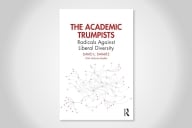You have /5 articles left.
Sign up for a free account or log in.

bobaa22/iStock/GettyImagesPlus
Thirteen tenure-track or tenured professors are finishing up their last semester at William Paterson University in New Jersey, having been laid off this year due to budget problems exacerbated by COVID-19.
Now professors who thought their jobs were safe—and who agreed to a number of concessions in order to save as many colleagues’ jobs as possible in the first round of cuts—are facing another, bigger round of layoffs: citing ongoing declining enrollment and a $30 million structural deficit, William Paterson proposed cutting 150 more professors over three years, or about 40 percent of the full-time faculty.
That number has since been reduced to 100 over three years, with the faculty union agreeing to even more concessions. It’s also possible that a few more professors will opt for special retirement packages by a January deadline. But the prospect of losing anything close to 100 professors, out of about 340 total, has the faculty at William Paterson worried about not just their jobs but the future of the institution as a whole.
“One hundred in three years will decimate our university,” said Susanna Tardi, professor of sociology and criminal justice and president of the American Federation of Teachers–affiliated faculty union. “The instability is a detriment for the people who are at the university whose jobs are not currently in danger but could be, depending upon the future. It’s a detriment to trying to develop programs that you think might be viable, because you don’t have the appropriate faculty to be able to serve those programs.”
A tenured faculty member who did not want to be quoted by name, out of fear of being targeted for the second round of layoffs, said, “Morale is terrible, yet faculty are still putting in overtime helping our students who have been hit hard by the ongoing pandemic.”
Classroom caps have been “raised drastically, and this will no doubt impact how we teach,” the professor also said. Whereas writing-intensive senior capstone courses used to have 15 students, they now have 30, for instance—a significant increase anywhere, but especially at a federally designated minority- and Hispanic-serving institution where many students are first-generation college goers who need extra support.
There is no pay for faculty members who do developmental student advising, either.
Along with the layoffs, William Paterson’s administration closed two academic majors—art history and geography—and put a number of other programs, including the major in Asian studies and the master of fine arts, on hiatus or probation.
Maggie Williams, who was promoted to full professor of art history last year and then laid off in the first round of faculty cuts, said, “I dedicated my entire career to William Paterson—by choice, because I believed in the mission—and I was there for 13.5 years. Since the minute I received the layoff notice last June, I have been iced out of every conversation that might have helped me to reverse the decision to lay me off.”
Williams said she was told at her layoff grievance hearing, for example, that her program was “overstaffed,” even though the courses she taught for many years served the college’s successful bachelor of arts program, not the art history program.
The institution’s research capacity also is compromised. During the first round of layoffs, the faculty union sacrificed research release time, sabbaticals and promotion-related pay increases for a year to save professors’ jobs. Now the faculty has agreed to these concessions for three years, in order reduce the second layoff target from 150 to 100.
Tardi said, “We practically gave up everything that makes us academics.”
Why Are Things So Bad?
New Jersey’s public colleges and universities have been hit hard by the pandemic, financially and otherwise. But the planned layoffs at William Paterson stand out in their scale. Why is the college taking such drastic steps?
Tardi and other professors attribute William Paterson’s structural problems to ever-declining state funding and decisions made under the university’s previous president, including building a $26 million parking garage that many students said was unnecessary. The university also opened a $40 million dorm in 2019—just ahead of the pandemic, which wreaked havoc on student housing revenue nationwide.
For all these reasons, Tardi said she braced for the possibility of second round of layoffs this year, albeit a small one. The 150-professor figure floored her, she said. And while the university has attributed the second round of layoffs to an unexpectedly large—12 percent—fall undergraduate enrollment decline, Tardi said, “They want to blame COVID. But COVID was the straw that broke the camel’s back, so to speak. COVID didn’t produce the problem.”
Tardi asked the university’s governing board for $500,000 last month to save five faculty jobs this year, but that request has not been granted. The union is now working with state legislators to try to secure more funding to save jobs.
Some faculty members think that William Paterson isn’t doing enough to save jobs with the money it already has. Stephen Shalom, a professor emeritus of political science who started teaching in 1977 and retired last year, recited an administrative rationale for the faculty cuts: that full-time faculty lines declined by just 1 percent between 2010 and 2020, during which time enrollments fell by 18 percent. While that’s “indeed a mismatch,” Shalom said, it’s “not nearly as big a mismatch as between upper administration and enrollment.”
Upper management positions have increased in number from 46 to 54 over the last 10 years, he said, and “the salary of a single top administrator could cover the cost of several junior faculty.
A university budget council was formed to brainstorm ways to save money besides layoffs, but the administration hasn’t adopted any of the group’s 50-some ideas, Shalom also said. He noted that the university’s last public audit, from 2019, says “the university’s financial position remains strong with total assets of $508.1 million as of June 30, 2019, a decrease of $15.5 million from fiscal year 2018 and a net cumulative increase of $2.1 million from fiscal year 2017."
According to documents from a financial forum from early 2021, William Paterson projected that it would add about $3 million to its reserves this year. That’s after the university said it had received $9.7 million in initial federal CARES Act money, only half of which was required to be spent on emergency assistance to students. Additional information from the financial forum shows that William Paterson planned to net $30.9 million in one-time emergency relief grants between 2020 and 2021. So the concern among some faculty members is that the university used emergency federal dollars, even indirectly, to build up its reserves instead of saving jobs.
Tardi disagreed with this idea, saying dwindling reserves prior to COVID-19 helped to lower William Paterson's financial outlook in 2021, and that there is a difference between restricted and unrestricted reserves.
Shalom, meanwhile, said, “The administration claims that we are compelled by financial necessity to take the unprecedented step of laying off tenured faculty. But there has never been a thorough audit that has been presented to the faculty showing that this is necessary. We have had to accept the administration’s word for this.” Of the financial information that the faculty has seen, he added, nothing suggests "that that $3 million could not be applied to saving faculty."
Asked about the CARES Act money, Stuart Goldstein, university spokesperson, said that after relief funds earmarked for students were delivered and “allowable expenses were charged against this fund, contributions to the reserves are not the result of net operating revenue and are one-time monies only.”
The federal funds therefore don’t address “the structural deficit the university is now facing as a result of the enrollment declines experienced over the past decade,” Goldstein said, adding that state appropriations haven’t returned to pre-recession levels “despite escalating costs.”
Shalom and others also said that William Paterson shouldn’t be trying to rightsize itself based on COVID-19–era enrollment numbers, given that the pandemic has disproportionately affected the minority populations that the university serves. Some professors also suspect that William Paterson’s ultimate goal is get rid of as many tenured faculty members as possible during the pandemic in order to hire back non-tenure-track faculty members for maximum flexibility.
Williams, the art historian who was already laid off, said that when she asked about how the art department will now move fine arts majors through their credit-heavy programs in time for graduation, she was told that art history will still be taught at William Paterson. Absent tenured art history professors, this suggests instruction will continue via non-tenure-track professors.
The faculty union contract prohibits this kind of maneuvering, but the union says the university has attempted it in the case of one professor of English who was laid off last year. The union is currently fighting for this professor’s job, and Tardi said winning the case is important in terms of precedent. Yet, ironically, she said, even if this professor’s job is saved, it could be slashed again in the second round of cuts.
On enrollment and rightsizing, Goldstein said that William Paterson “has experienced a significant enrollment decline over the last decade. In 2011 total enrollments were 11,518 and in 2021 they were 9,886, which is a 14 percent overall decline. More dramatically, full-time undergraduate enrollment, which accounts for a vast amount of tuition and fee revenue, in 2011 was 8,426 and in 2021 was 5,708, which is a 32 percent decline.”
He added, “The university must take this difficult and painful corrective action to rightsize in order to begin to fiscally operate without a substantial fiscal deficit and remain good stewards of taxpayer dollars.”









